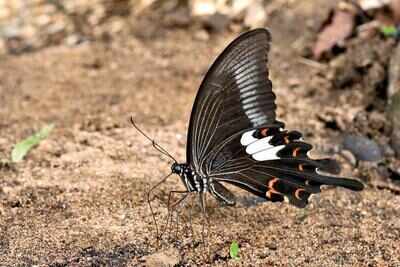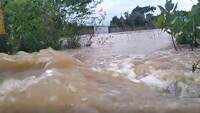
Surat: On August 5, Rajdeepsinh Jhala, assistant conservator of forests at Kevadia Division, was overjoyed when he spotted Red Helen butterfly near his official residence on the forest colony campus in Rajpipla town of Narmada district. There was a reason for his joy. This was the first record of Red Helen in the state after 1957. He soon took a video of the species.
Red Helen Butterfly (Papilio helenus daksha) was spotted in Ahwa in Dang district, which is considered the northernmost part of the Western Ghats, by scientist E M Shull in 1957. This was the first (and the last record) sighting of this butterfly species. Now, after almost 63 years, Red Helen was spotted again in the state,” Prof Sujit Prajapati, assistant professor, Government College of Science, Limkheda, told TOI.
“Red Helen is a large swallowtail butterfly and is found in forests of southern India. Mostly it is found in the Western Ghats. As more people have started watching butterflies and exploring forests and non-forest areas, we will come across such new species records and rare sightings in the state,” Prof Prajapati added.
Red Helen was also spotted near the Statue of Unity in Kevadia as well during the same period.
“There is a need to create awareness about butterfly watching and butterfly gardening among people especially among children in the state. Central and South Gujarat have a good biodiversity, and concerted efforts can help us find more species sightings and new species records in the state. Red Helen butterfly prefers dense forests,” said Rajdeepsinh Jhala, assistant conservator of forest at Kevadia Division, who was instrumental in developing butterfly garden near Statue of Unity at Kevadia.
Prime Minister Narendra Modi had opened butterfly Garden at Kevadia last year and released butterflies.
Forest officials said that Red Helen is commonly found from Kerala to Maharashtra and north eastern states of the country.
According to ‘A Guide to the Butterflies of Western Ghats (India)’ book: “It restlessly hovers from flower to flower. Males visit damp patches in large numbers. This butterfly rests on the upper surface of a leaf with its wings open and the fore wing drawn down over the hind wing hiding the white patches.”
Red Helen Butterfly (Papilio helenus daksha) was spotted in Ahwa in Dang district, which is considered the northernmost part of the Western Ghats, by scientist E M Shull in 1957. This was the first (and the last record) sighting of this butterfly species. Now, after almost 63 years, Red Helen was spotted again in the state,” Prof Sujit Prajapati, assistant professor, Government College of Science, Limkheda, told TOI.
“Red Helen is a large swallowtail butterfly and is found in forests of southern India. Mostly it is found in the Western Ghats. As more people have started watching butterflies and exploring forests and non-forest areas, we will come across such new species records and rare sightings in the state,” Prof Prajapati added.
Red Helen was also spotted near the Statue of Unity in Kevadia as well during the same period.
“There is a need to create awareness about butterfly watching and butterfly gardening among people especially among children in the state. Central and South Gujarat have a good biodiversity, and concerted efforts can help us find more species sightings and new species records in the state. Red Helen butterfly prefers dense forests,” said Rajdeepsinh Jhala, assistant conservator of forest at Kevadia Division, who was instrumental in developing butterfly garden near Statue of Unity at Kevadia.
Prime Minister Narendra Modi had opened butterfly Garden at Kevadia last year and released butterflies.
Forest officials said that Red Helen is commonly found from Kerala to Maharashtra and north eastern states of the country.
According to ‘A Guide to the Butterflies of Western Ghats (India)’ book: “It restlessly hovers from flower to flower. Males visit damp patches in large numbers. This butterfly rests on the upper surface of a leaf with its wings open and the fore wing drawn down over the hind wing hiding the white patches.”

Coronavirus outbreak
Trending Topics
LATEST VIDEOS
City
 New normal: Delhi hotels at your service with hidden smile
New normal: Delhi hotels at your service with hidden smile  Alarming: Incessant rain creates flood-like situation in Odisha's Balasore
Alarming: Incessant rain creates flood-like situation in Odisha's Balasore  Covid-19: Two Pune volunteers first to get trial dose of Covishield
Covid-19: Two Pune volunteers first to get trial dose of Covishield  Pune gets its first jumbo facility: 200 ICU beds, 600 oxygenated beds added in fight against Covid-19
Pune gets its first jumbo facility: 200 ICU beds, 600 oxygenated beds added in fight against Covid-19
More from TOI
Navbharat Times
Featured Today in Travel
Quick Links
Kerala Coronavirus Helpline NumberHaryana Coronavirus Helpline NumberUP Coronavirus Helpline NumberBareilly NewsBhopal NewsCoronavirus in DelhiCoronavirus in HyderabadCoronavirus in IndiaCoronavirus symptomsCoronavirusRajasthan Coronavirus Helpline NumberAditya ThackerayShiv SenaFire in MumbaiAP Coronavirus Helpline NumberArvind KejriwalJammu Kashmir Coronavirus Helpline NumberSrinagar encounter
Get the app



